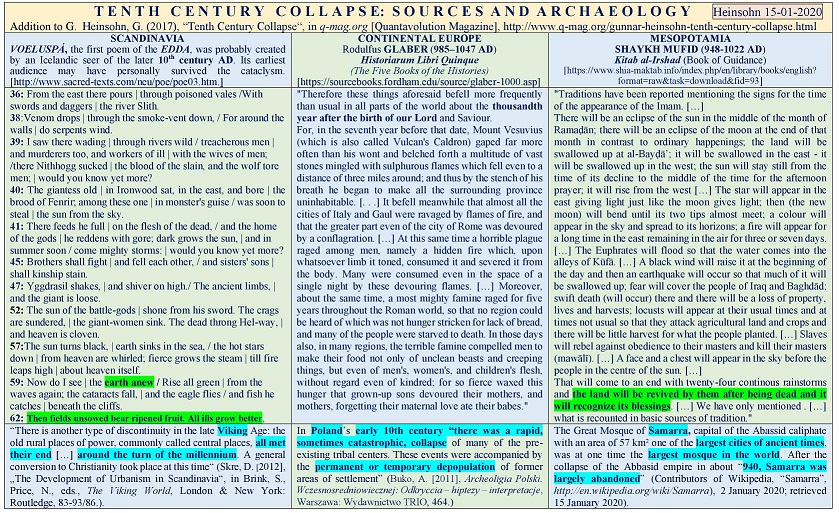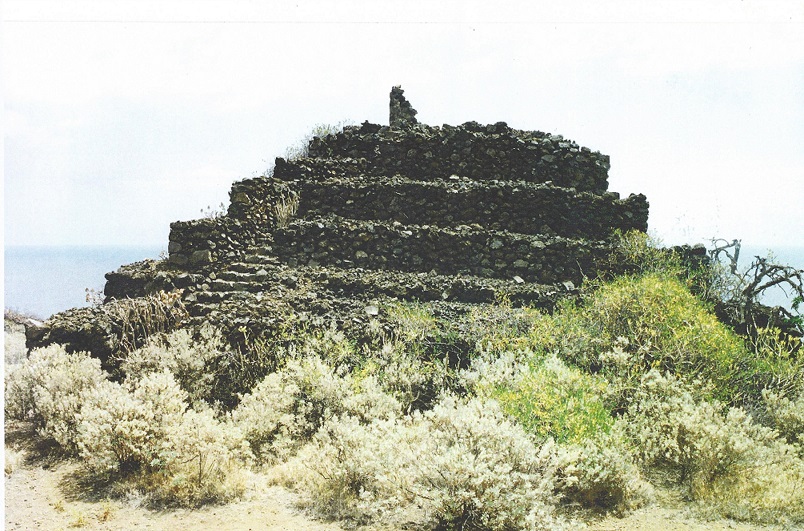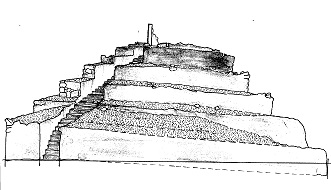Actualities 2020
deutsch english español français
Berlin · 2020 Uwe
Topper ![]()
In 2017, we started to share the news of the moment in an informative ever growing article. This idea was continued 2018 and 2019 and will be likewise this year, too. For the moment here an English summary of the items:
What's new in 2020?
Our Archive of old articles has started
Dr. Dr. Paul C. Martin, early combatant for chronology analysis, has died at the age of 80, on April 3, 2020
The Institutum Canarium (Vienna) announced its closure by the end of 2019
Bad news concerning cart tracks
New articles on the theme of Dante's dates, now available in English:
Dante portrayed by Duerer
and resuming the whole issue: Dante's life dates
Just now: Johnson's book of 1904 translated into German
Did you know that Edwin Johnson, who died 1901 and had published an important book about the Pauline Epistles, really enlightening for chronology criticism, had been honoured by his friend Edward Petherick with the posthumous edition of his manuscript "The Rise of the English Culture" in 1904 ? (link here) The New York Times of May 14th, 1904 wrote an enthusiastic review of it (find it here). And now the first part of this book as well as the "Pauline Epistles" has been translated into German by Wolf Odinson, a translation that is open and freely accessible ![]() (here). We are glad this effort has been undertaken and so well done.
(here). We are glad this effort has been undertaken and so well done.
Just by the way I want to mention that Johnson in this book also doubts the date of Dante's Divine Comedia and puts it rather to the end of the 15th century (page 66 f).
An important fore-runner of Johnson - apart from father Hardouin - was John Wilson Ross (1878): Tacitus and Bracciolini. The Annals Forged in the XVth century (London). You find his book in internet here.
And yet another author confirms that Tacitus is forged: Leo Wiener in his book of 1920 ! ![]() We have a short review here.
We have a short review here.
There is a reply of Gunnar Heinsohn to Trevor Palmer's arcticles in SIS-Review (in several sequences and now complete) stating that the 1st millennium Christian era does not allow any reduction.
With irony but not malevolent, Heinsohn gets to the point: By constant repetition of school knowledge the discrepancies therein do not vanish because anachronisms in orthodox teaching are so striking that it is surprising why this was not discussed as radically as Heinsohn is now doing.
If German history-textbooks had shown the chronology problem occourring between antiquity and the high Middle Ages so clearly before, this daring attac would not be necessary, says Heinsohn. And with that he adds three more stumbling steps.
I want to pick out one that concerns Sopot near Danzig and is similar to findings in London:
"Still, one has the Early Middle Ages. But this period looks strange because people living in the 9th century apparently used Roman coins coined in the 2nd century. There are elaborate theories to justify the use of a currency that has been obsolete for 700 years ( cf. Heinsohn 2018b). " (P. 8)
It sounds strange that traders are said to have used classic Roman coins, even in the Middle Ages. How about the Seven Dormants in the cave? (see Topper 1994) When after awaking they sent one of them to the market with a coin to get bread, he was quickly suspected by his coin, which was a few hundred years old. At that time, traders payed attention to a coin before accepting it as a means of payment in the market. This should also be practised by archaeologists in the case of larger quantities (apart from isolated hoard finds).
With schemes showing simplified arguments Heinsohn makes clear to the reader, regardless of previous education, that academic historiography - and thus the material collected by Palmer - is full of contradictions and can no longer be used in this way.
But is this new to us? Or for attentive colleagues like Palmer?
Heinsohn says p. 7: "and as I myself did at least partially until 2013 (believe) in the validity of mainstream chronology for this millennium."
Heinsohn admits by the word "partially" that for more than 20 years, together with Illig, he had shortened the 1st millennium by 300 years, which now benefits him because he continues the direction once taken - uncovering doubles (even triples) of personalities and events as well as artificial gap-filling of invented centuries with phantom figures.
In addition, it was not Heinsohn and Illig alone who courageously opened this way. The humble reviewer has taken part in it since 1993, albeit partially with differing answers to the problem.
Unfortunately, Heinsohn stopped at some point. He does not clarify the reason (the trigger) for the whole dysfunction of the chronology. Perhaps the Dark-Earth-Layer in London as catastrophe horizon is already the answer, but he did not elaborate as far as I know.
Heinsohn in a personal communication writes: "On https://q-mag.org/gunnar-heinsohn-polish-origins.html (p. 53) my first speculation on the reason for the wrong chronology has been published."
He also agrees that chronological anomalies do not end with the year 1000 AD and do not dissolve unnoticeably into "secured" chronology but remain incomprehensible for another four centuries well into the second millennium.
As regards the collapse of European civilisation roughly 1000 years ago, have a look on this scheme of Heinsohn:
 References
References
Heinsohn, Gunnar : Palmer-defense of first millennium chronology-Heinsohn-12-12-2019.pdf
(2018b)„Polish Origins„, in q-mag.org [Quantavolution Magazine]; https://q-mag.org/gunnar-heinsohn-polish-origins.html
Palmer, Trevor: The Writings of the Historians of the Roman and Early Medieval Periods and their Relevance to the Chronology of the First Millennium AD, in C&C Review 2015 ff.
Topper, Uwe: Die Siebenschläfer von Ephesos; in: Vorzeit-Frühzeit-Gegenwart 1/1994, S. 40-55, here in the library
The theologian Hermann Detering, persistant skeptic and denier of the historicity of Jesus, pastor in Berlin and gifted painter, succumbed to cancer on October 18, 2018. In the past few years he had been living away from Berlin in the region Altmark, which is why my personal contact with him had broken off and it is only now that I learn about his death.
See here for the obituary.
My review of his most important book False Witnesses (2011) in our library, finally translated into English.
An English version of Detering's work: Traces of Indian philosophy in the writings of the gnostic Basilides, translated by Dr. Michael Lockwood, is open on his website radikalkritik.de (in 2 parts).
http://radikalkritik.de/wp-content/uploads/2018/09/Basil_part1_b.pdf
http://radikalkritik.de/wp-content/uploads/2018/09/Basil_part2_b.pdf
The Institutum Canarium (Vienna) announced its closure
The Institutum Canarium (Vienna), siglas IC, with which I have worked for 40 years, announced its closure by the end of 2019, while celebrationg its 50th anniversary. Only the yearbook "Almogaren", in which I published 13 articles, will continue to be published under the leadership of Hans-Joachim Ulbrich as before.
In the last "Almogaren" (no. 50) there are interesting articles again, I would like to emphasize that of Rudolf Franz Ertl: "50 years in the service of researching the Canaries, comparative rock art research and Mediterranean cultures" (pp. 275-322). There is a section on the mysterious pyramids in the Canary Islands that still leave many questions unanswered.
In 1991, a large pyramid with eight steps at La Mancha was crushed by machines despite protests by some citizens. It is only since Thor Heyerdahl campaigned for the pyramids of Guimar that one begins to show consideration. Nevertheless, many questions have so far not been answered, namely
what these buildings could have served for,
where the recognizable foreign stones come from,
what cult acts or rites could have taken place on the buildings,
whether they contain astronomical information
or whether they are graves. Have a look (foto and drawing both by Prof. Ertl, 2009) at the pyramide of Playa de los Cancajos (La Palma); the little tower on top is much younger than the building. View from WSW, in the background the ocean.


And now comes the surprise:
"On a pyramid examined by the author on La Palma, he made a remarkable finding. In the lowest pyramid platform, he found during surveying work buried stone chambers, the purpose of which can only be speculated as long as no excavation provides us with further knowledge." (P. 281)
Rudolf Franz Ertl informs me that he found those chambers already in 2001 y 2003. They are not big, measuring merely 1 by 2 m, and could have served for burials. The authorities did not even allow excavation of them.
For reference see the following articles:
Ertl, Rudolf Franz (2009): Neu entfacht: Pyramidendiskussion auf den Kanarischen Inseln (Almogaren XL, p. 134--143)
Hähnel, W. B. (1996): Die Pyramiden von Tenerife (AlmogarenXXVII, p. 359-374)
Peiffer, KH. (1999): Pyramidenforschung mit Schwerpunkt Kanaren (IC-Nachr. 82, p. 33-35)
Pichler, W. (1997): Der Streit um das Alter der kanarischen "Pyramiden" (Almogaren XXVIII, p. 89-96)
Even if the chambers look like graves, it does not define these pyramid buildings as graves. The assembly of several platforms and step structures suggests a larger cultic use, such as I propose for our northern megaliths whose inner chamber looks like a crypt (see quote from the book by H. Wille), comparable to our Romanesque and Gothic domes. Cologne Cathedral is built above the coffin that contains the bones of the Three Magi, but this does not make the cathedral a burial site. The coffin with the relics consecrates the cathedral, but the cult was practiced in honor of the Almighty God, or the Savior whom the Three Magi also worshiped. Likewise these step pyramids might contain chambers with bones of the ancestors without being tombs.
Note: For the Canary Islands with their rock art, their peculiar language before the Spanish conquest, their ethnic mix and cultural remains, see my book "Das Erbe der Giganten" 1977, chap. 16, especially p. 318 ff. At that time the pyramids of the Islands were still unknown. My copies of rock art on Gran Canaria and El Hierro are published in IPEK 23 (1970) by Herbert Kühn, the drawings became the property of the IC.
Bad news concerning cart tracks
Nothing new for the wellknown cart tracks on rock surface? How strange! There should be lots of questions and new theories, more discoveries and thorough investigation.
After all – dino tracks are known to man since the stone-age. They have been good for curiosity and superstition, veneration and fear. In the Christian Age they were held to be signs of the adversary of God, the Satan or devil. Or testimonies of saints with superhuman power. Anyhow, they were and are a puzzle and are documents of long extinguished life.
Not so the cart tracks.
The phrase I once quoted: "They will remain the horror for generations of archeologists to come" (José Sabater 1877, see Topper 1977, p. 201) did not get fulfilled. After scientists found out that these cart tracks present a riddle or rather a problem to the mind, they were swiftly forgotten ("not my business").
More and more cart tracks (or cart ruts, as they were called on Malta) have come to light, and the questions became more and more complex. There is an interview with paleontologist Luiz Carlos da Silva Gomes in Brazil, who mentions that footprints of dinosaurs are at the same spot with the tracks (see our news 2019). Alone the fact that we have prehistoric tracks of wheeled vehicles in America is so astonishing that we should stop for a second to assimilate this news. As well as cart tracks on the Azore Islands and the Easter Island (same note 2019).
There are ancient cart tracks which were continued by the Romans, albeit with a smaller width (down to 110 cm). Yet I don't know of any Roman author to have mentioned them.
The far elder ones are also much wider (up to 180 cm). And more broken up, weathered away, covered ...
So I consider this to be "sad news" – no work being done by specialists, not even protection of the cart tracks as documents of the human past.
good introduction: www.ilya.it/chrono/enpages/gleiseen.html
more news: www.ilya.it/chrono/enpages/Neueste19en.html#carttracks
Innovation: We have started a new branch on this site, an archive of old articles which are not easy to find in the web.
More news are going to be added. You can give hints or articles here.
![]() I would like to write a comment to this text:
I would like to write a comment to this text: